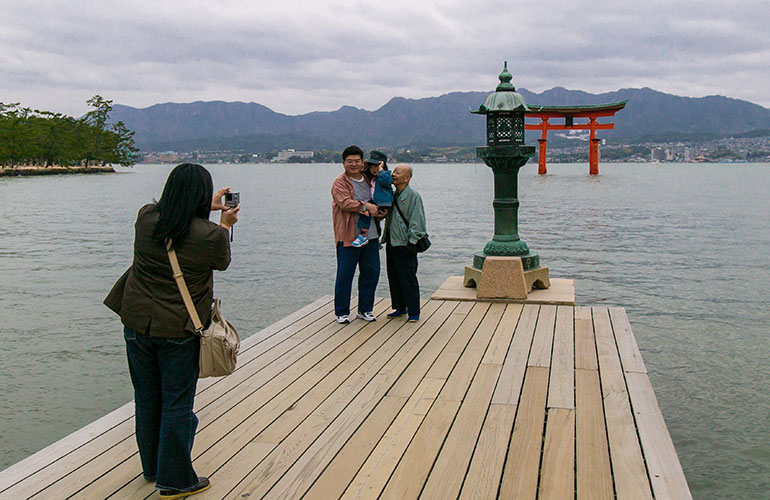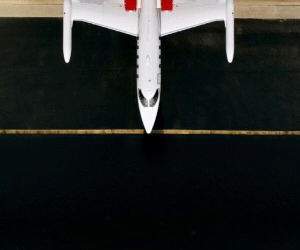How to Choose the Right Camera for your Travel Photography
 Snapping a family photo in front of the Itsukushima Shrine in Miyajima, Japan. Photograph by Josh Laronge
Snapping a family photo in front of the Itsukushima Shrine in Miyajima, Japan. Photograph by Josh Laronge Ansel Adams had it easy. When he was photographing the American West there were few choices of cameras for travel photography, and most of those choices were big, heavy, and expensive and took the knowledge of a pro to use. For photographers today, there are lots of options, and choosing a camera for travel can be a daunting task. While price is always a consideration, the two most important criteria when selecting a camera for travel photography are image quality and physical size. Today’s digital cameras come in four size categories: pocket, enthusiast, mirrorless and DSLR. We’re going to look at each category—and recommend good cameras in each—so you can figure out which to take on your next trip.
Pocket Cameras
Pocket cameras are the smallest and least expense. They come with very few features, and usually their image quality and performance is mediocre. It’s very hard to recommend pocket cameras these days as most of the cameras in smartphones will equal or surpass them in image quality and performance. Plus, smartphones will have larger screens and allow you to easily share your images via email, text or on a social network like Instagram or Facebook.
Enthusiast Cameras
For the photo enthusiast who wants better pictures than smartphones are capable of snapping, but still wants a camera that will fit into a pocket, there’s a category known as enthusiast or advanced point-and-shoot cameras. These have two main features that put them above smartphones and pocket cameras: larger imaging sensors and “very fast” lenses (meaning they’re able to allow a lot of light to come in the camera, which translates into better pictures, especially in low light).
Sensor size is really important in camera choice because it affects image quality: The larger the sensor, the better the image quality. To put this in perspective, the smallest sensors that are found in pocket cameras and smartphones are less than a 1/4 inch when measured diagonally. In enthusiast and advanced point-and-shoot cameras, the image sensors range in size from a 1/2 inch to an inch; while in mirrorless and DSLRs the image sensors range in size from 1 and 1/4 inches to 1 and 3/4 inches.
Enthusiast cameras offer fully automatic shooting as well as semi-manual and fully manual settings so that the photographer can customize how their pictures will look. Many of these cameras also offer “scene modes” that allow a photographer to tell the camera what type of picture they are taking (i.e. portrait, landscape, sports, close up, etc.) so the camera will optimize the settings for best results.
The other feature that sets the best enthusiast cameras apart is a viewfinder, either built-in or as an optional external add-on. In bright sunlight, it can be challenging to shoot pictures using the screen on the back of the camera. Sunglasses, especially polarized ones, will also make it tough to see the display. But a viewfinder will remedy this problem, making it much easier to compose your photos.
Expect to pay between $400 and $900 for a good enthusiast camera and don’t forget to buy extra batteries and memory cards. As of this writing, here are the best enthusiast or advanced point-and-shoot cameras:
Read our reviews: The Best Enthusiast Cameras for Travel Photography
Mirrorless Cameras
Mirrorless is the newest category of digital cameras. In fact, the category is so new there’s still a debate about what to call it: Since DSLRs are really the only ones with mirrors in them, technically all cameras except DSLRs are mirrorless. However, the mirrorless cameras we’re going to look at all have the ability to allow the photographer to change lenses, setting them apart from the enthusiast cameras.
With sensors much larger than the enthusiast class of cameras, mirrorless models offer outstanding image quality, speedy performance, and both automatic and manual control. Sizewise, mirrorless cameras fit in between enthusiast cameras and DSLRs; they won’t fit in your pocket but, they also won’t feel like an albatross dangling from your neck.
This category of cameras is quickly becoming the travel camera of choice for professional photographers when they’re on vacation. Pros are used to lugging equipment for paid assignments and the last thing they want to do while on vacation is lug gear. Yet with mirrorless cameras, you can get most of the performance and image quality of a DSLR in a much smaller, lighter and less expensive package.
Mirrorless cameras come both with and without viewfinders. Some of the models that don’t have built-in viewfinders offer them as an accessory. As with the enthusiast cameras, it’s best to get one with a viewfinder. Also, you’ll probably want a small camera bag and a few accessories such as a protective filter for the lens, extra batteries, memory cards and a lens cleaning cloth.
You can purchase mirrorless cameras as a kit with a lens or as body-only and select a lens. Most of the lenses packaged as kits with mirrorless cameras are pretty good. However, many of the manufacturers do offer upgraded lenses. To get these, you’ll either buy the camera body-only and then the lens separately (which will cost you a little more than buying the kit), or you can buy the kit first and then upgrade the lens later. If you are planning to upgrade your lens, be aware that the kit lens has very little value if you try to sell it, and you probably won’t ever use it again after upgrading. So if you’re thinking about getting a better lens, it’s really best to buy the camera body-only and the better lens separately—it will be cheaper in the long run.
Mirrorless cameras are the future of photography. Expect to pay between $400 and $1,700 for a mirrorless camera with lens. As of this writing, here are the best mirrorless cameras:
Read our reviews: The Best Mirrorless Cameras for Travel Photography
DSLRs
This is the most advanced category of digital cameras—these are the ones the pros use. There’s no question they produce the best image quality, have the fastest operational speed and the most features. They’re also the largest, heaviest and most expensive of all the camera types. It’s strongly advised that before you buy a DSLR for travel photography you go to a store and feel the size and weight of it. Many travelers who buy DSLRs end up leaving them at home or in their hotel rooms, as they don’t enjoy carrying such a heavy camera around all day.
DSLR stands for digital single lens reflex, which in non-tech speak means the camera is digital, has one lens (that can be changed) and has a mirror inside the camera that flips out of the way when the photo is being taken. The biggest advantage of these cameras are the viewfinders, which offer what-you-see-is-what-you-get viewing without the lag of an electronic viewfinder (go to a camera store and look through both an optical viewfinder and an electronic one to see the difference). DSLRs focus and shoot much faster than other classes of cameras (although mirrorless is quickly catching up). They also offer the most extensive system of lenses, flashes and other accessories.
Pricing for DSLRs starts around $500 with a kit lens; however, even though you can buy a DSLR for less than the price of some of the other cameras mentioned in this article, it’s not recommended that you do so. To keep price points low, camera manufacturers build their low-end cameras and lenses with plastic instead of metal and minimize external controls in favor of menu-driven operation which isn’t always desirable. Here are the current best mid-range to high-end DSLRs:
Read our reviews: The Best DSLR Cameras for Travel Photography
—by Josh Laronge for wendyperrin.com
Josh Laronge is a professional photographer, photo educator and avid traveler. He’s photographed on all seven continents and his photos are published in a wide range of periodicals.
Read our full guide to the best cameras for travel photography:
Best Enthusiast Cameras for Travel Photography







